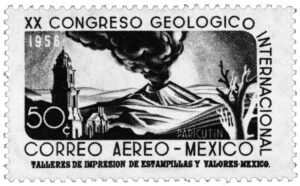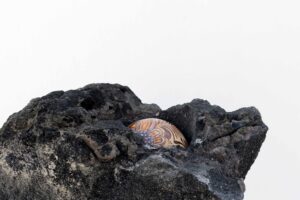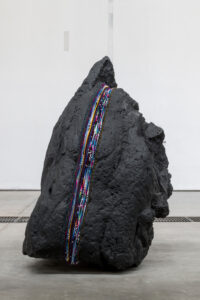25.04.2024
EXTRACT is an online section where we share some of the texts published by Temblores Publicaciones, the publishing imprint of Terremoto. We present “Atravesar la historia de un volcán para llegar aqui” by Paulina Ascencio Fuentes and Sandra Rozental, from Habitar el colapso. A review of Cynthia Gutiérrez’s exhibition of the same name here.
Going through the history of a volcano to get here
By Paulina Ascencio Fuentes and Sandra Rozental.

In the archives of the Museum of the Institute of Geology of the UNAM, a very particular birth certificate is documented. By means of a bureaucratic registry as it corresponds to any member of the citizenry, and with the official seal of the Municipal Presidency of Parangaricutiro, Michoacán, the document reports the advent of a new being and recognizes it as part of the community. However, unlike humans, this being does not breathe air, but fire. It is a being that spat boiling lava, a dragon of earth and stone that emerged in the middle of a cornfield in the Purepecha Plateau on February 20, 1943: the Paricutin volcano. The act, an unusual record to account for the birth of a geological entity in a bureaucratic key, allows us to glimpse how the State and its institutions transformed it into a mirror in which to look at itself and from which to reflect an image of Mexico to the rest of the world.
to the rest of the world.
Emerging from the effects of another volcano, this one of a metaphorical order -the Mexican Revolution-, with its own material and topographical consequences, the Mexican State, far from an environmental and social catastrophe, saw in the birth of Paricutin a fertile national symbol. The volcano that was born from a cornfield soon became a spectacle, a stage and backdrop for an epic plot that reflected the ideals of the post-revolutionary project of transformation and modernity.

The towns of San Salvador Combutzio (known as Parícutin) and San Juan Parangaricutiro were buried under the lava and their inhabitants and those of other affected communities, such as Zacán, Santa Ana Zirosto and Angahuan, were gradually displaced and relocated from their ancestral territories to new towns and colonies such as Nuevo Zirosto, San Juan Nuevo, Caltzontzin and Doctor Miguel Silva. Meanwhile, the government promoted and even sponsored the show. Tourists and scientists gathered to sample and evaluate the newborn volcano. The most renowned artists of the time, such as Diego Rivera, David Alfaro Siqueiros, Dr. Atl, and Rufino Tamayo, came to the locality to portray Paricutzin as a great monument to the autochthonous specificity of the national landscape.
Scientists resorted to cutting-edge tools and technologies to capture and disseminate impressive images. The constant eruption cycles gave way to experimentation through aerial views, night shots and powerful chromatic contrasts. While outside eyes were able to admire every instant of volcanic activity, the black mountain was eating the way of life of thousands of Purépecha peasants. Two of their villages were devoured by the sea of lava and the rest of their land, crops, livestock, and other sources of survival were engulfed by a thick, dark layer of ash.

For their part, the retablos in the church of San Juan Parangaricutiro showed the anguish of the people who assumed the catastrophe as a divine punishment for earthly misunderstandings. Created by Purépecha hands, these devotional paintings are another kind of mirror in which we can intuit -if not see at all- glimpses of how local people experienced the birth of the volcano. In one of them, a cross protrudes from the mouth of the volcano that spits fire on the horizon. In front, a lady prays kneeling in front of her house, while cows and oxen run around the corral, agitated by the fright.
If you want to continue reading, we invite you to buy the book Inhabiting the Collapse in our online store.
Comments
There are no coments available.